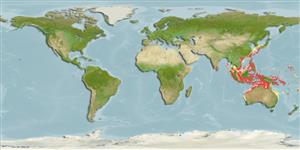分類 / Names
俗名 | 同種異名 | Catalog of Fishes(屬, 種) | ITIS | CoL | WoRMS | Cloffa
Teleostei >
Gobiiformes (Gobies)
鱸形目 (Gobies) >
Gobiidae (Gobies)
鰕虎魚科 (Gobies) > Gobiinae
Etymology: Eviota: No etymology given, suggested by Christopher Scharpt: from Latin 'eu' for 'true' and 'iota' for anything very small, in combination 'truly very small' referring to it as being the smallest vertebrate at the time it has benn described by Jenkins (thus, making the suggestion by Scharpt plausible..
Environment: milieu / climate zone / depth range / distribution range
生態學
海洋 底中水層性; 深度上下限 0 - 60 m (Ref. 85778).
Eastern Indian Ocean to Western Pacific: Ryukyu Islands, Brunei, Indonesia (N. Sulawesi & West Papua), Papua New Guinea, Philippines, Palau, Western Australia, and Sri Lanka.
大小 / 重量 / 年齡
Maturity: Lm ? range ? - ? cm
Max length : 2.4 cm SL 雄魚/尚未辨別雌雄; (Ref. 81713)
簡短描述
型態特徵 | 形態測量圖
背棘 (總數): 6 - 7; 背的軟條 (總數): 8-9; 臀棘 1; 臀鰭軟條: 8 - 9. This species have the complete cephalic sensory-canal pore configuration, pores B', C (unpaired), D (unpaired), E, F, H', N' and O'. It differs from the other species of this subgroup in having the following set of characters: usually 9 dorsal-fin and 8 anal-fin segmented rays; well-developed membranes between pelvic-fin segmented rays; densely pigmented on edge of scale pockets, forming dusky reticulations on body; middle of first dorsal fin with a narrow arc-shaped, diagonal pale band (subtranslucent in preserved specimen); 5-7 diagonal bright-blue to pale-blue bars (translucent and sometimes quite indistinct in preserved specimens) on second dorsal and anal fins in each; 2 ovoid dusky spots on dorsal and ventral parts of pectoral-fin base; absence of an enlarged, distinct subcutaneous dusky spot on mid-lateral caudal peduncle; caudal fin with no conspicuous dusky markings (Ref. 81713).
Inhabits coral reefs (Ref 90102).
Life cycle and mating behavior
成熟度 | 繁殖 | 產卵場 | 卵 | 孕卵數 | 仔魚
Shibukawa, K. and T. Suzuki, 2005. Two new species of the gobiid fish genus Eviota (Teleostei, Perciformes, Gobioidei) from the Western Pacific. Bull. Natl. Sci. Mus. Ser A 31(2):65-76. (Ref. 81713)
人類使用
更多資訊
俗名同種異名新陳代謝捕食者生態毒物學繁殖成熟度產卵場產卵群集孕卵數卵卵發育
年龄/大小成長長度-重量長度-長度長度-頻率形態測量圖型態特徵仔魚稚魚動力學入添量豐度BRUVS
參考文獻養殖養殖資訊品種遺傳學Electrophoreses遺傳率疾病加工NutrientsMass conversion
合作者照片Stamps, Coins Misc.聲音神經毒速度泳型鰓區Otoliths腦重體重比眼睛色素
工具
特別的報告
下載 XML
網路資源
Estimates based on models
Preferred temperature (Ref.
123201): 25.4 - 29, mean 28.1 °C (based on 538 cells).
Phylogenetic diversity index (Ref.
82804): PD
50 = 0.5000 [Uniqueness, from 0.5 = low to 2.0 = high].
Bayesian length-weight: a=0.00708 (0.00333 - 0.01504), b=3.09 (2.92 - 3.26), in cm total length, based on LWR estimates for this (Sub)family-body shape (Ref.
93245).
營養階層 (Ref.
69278): 3.1 ±0.3 se; based on size and trophs of closest relatives
Fishing Vulnerability (Ref.
59153): Low vulnerability (10 of 100).
